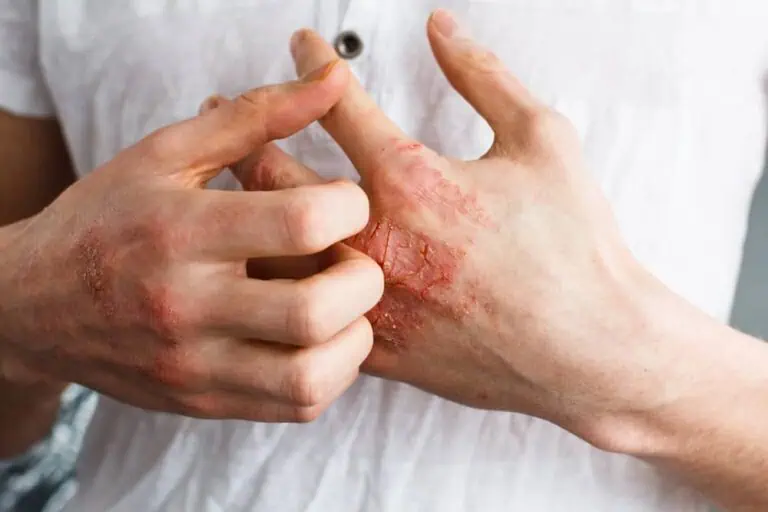Eczema vs. Psoriasis: What’s the Difference?

Most people get the occasional bout of dry, itchy skin, and it’s often nothing a good moisturizer can’t fix. But if patches of dry, red, inflamed skin keep coming and going, a chronic skin condition such as eczema or psoriasis may be to blame. How can you tell if it’s eczema vs. psoriasis? Surely there are dead giveaways that it’s one or the other?
Not necessarily.
“While there are some clues that can help set them apart, the difference between eczema and psoriasis is more subtle than many people realize,” said Robert Snyder, MD, a board-certified dermatologist and internist at Riverchase Dermatology.
Not even the severity of symptoms can tell you which condition you have. “It’s a common assumption that psoriasis symptoms are much worse than eczema symptoms, but both conditions can range from mild to severe,” Dr. Snyder added.
To add to the confusion, it’s possible to have eczema and psoriasis at the same time, though that’s uncommon (phew). Read on to learn more about these conditions and the symptoms of eczema vs psoriasis.
What is eczema?
Eczema is an inflammatory skin condition in which the immune system overreacts to certain triggers, including irritants and allergens. Itching leads to scratching and then an eczema rash. Common eczema triggers include skincare products, detergents, fragrances, hot or cold weather and stress. The exact cause of eczema is unknown, but it’s thought to be a combination of environmental factors and genetics.
What is psoriasis?
Like eczema, psoriasis is driven by inflammation, and the symptoms can be worsened by triggers such as allergens and certain weather conditions. But unlike eczema, psoriasis is an autoimmune disease. In these diseases, the immune system mistakenly attacks healthy tissue. If you have psoriasis, your immune system is constantly in overdrive. This causes new skin cells to grow up to 10 times faster than usual and pile on top of the skin instead of shedding. The result is raised patches. What causes psoriasis isn’t well understood, but as with eczema, genetic and environmental factors are probably involved.
What does eczema look like?
There are several types of eczema. The most common one, atopic dermatitis, involves dry, cracked skin that itches. Scratching causes a rash that’s red in people with lighter skin and may be brown or purple in people with darker skin. You may notice scaly patches or see small, rough bumps that ooze a clear or straw-colored fluid and eventually crust over. Over time, you may develop thick, leathery patches of skin.
What does psoriasis look like?
The most common type of psoriasis, plaque psoriasis, causes thick, raised patches called plaques. Psoriatic plaques can look a bit like an eczema rash and are similar in color, but they are typically covered in distinctive silvery-white scales or, in dark skin, gray scales. It’s harder to tell the conditions apart if you have early psoriasis, since the only symptoms of early psoriasis tend to be an inflamed, raised patch of skin and itching.
The difference between psoriasis and eczema: potential clues
Eczema is between three and four times more common in the United States than psoriasis, but psoriasis affects more than 8 million people nationwide, so don’t discount it as a possibility. Here are some clues that help distinguish psoriasis vs eczema.
- Oozing. Unlike an eczema rash, psoriatic plaques don’t ooze. “Oozing is probably the closest thing to a telltale sign that a patient has eczema and not psoriasis,” said Dr. Snyder.
- Level of itching. Itching is the most common symptom of eczema, and at times, it can be intense. Psoriasis also causes itching, but it’s usually milder.
- Level of pain. Eczema usually doesn’t hurt, though it can sting or burn, especially if you scratch hard enough to break the skin. Psoriasis is more likely to be painful, causing stabbing, throbbing or aching sensations.
- Skin thickness. Psoriatic plaques are usually thicker than the leathery patches of skin sometimes seen in eczema.
- Age symptoms first appear. Both conditions can emerge at any age, but eczema most commonly develops in babies and children and sometimes persists into adulthood. Psoriasis is likely to first appear between ages 15 and 35.
- Affected areas. Eczema and psoriasis can appear on any part of the body, but eczema is most likely to show up on the hands, face, back of the neck, back of the knees and crooks of the elbow. Psoriasis often appears on the knees and elbows as well (on the front of the knee and outer elbows, however) and also the scalp and lower back.
- The edges of the dry patches. Psoriasis plaques have sharply defined edges, while the edges of eczema patches are less distinct.
- Nail symptoms. Eczema and psoriasis can affect the fingernails and toenails. Both conditions can cause pitting (pinprick holes) in the nails, but people with nail psoriasis may also notice white discoloration and lifting of the nails from the nail bed.
If you suspect you have eczema or psoriasis, see a dermatologist. Left untreated, both conditions can decrease your quality of life and even contribute to depression.
“Psoriasis in particular should be treated right away,” said Dr. Snyder. “If you have it, you’re at greater risk for psoriatic arthritis as well as cardiovascular disease, type 2 diabetes and high blood pressure.”
Your dermatologist can provide an accurate diagnosis and develop a treatment plan that’s right for you.
Schedule an appointment today if you have symptoms of eczema or psoriasis.
Medically reviewed by Robert A. Snyder, MD
Written by Jessica Brown, a health and science writer/editor based in Nanuet, New York. She has written for Water’s Edge Dermatology, Prevention magazine, jnj.com, BCRF.org, and many other outlets.


